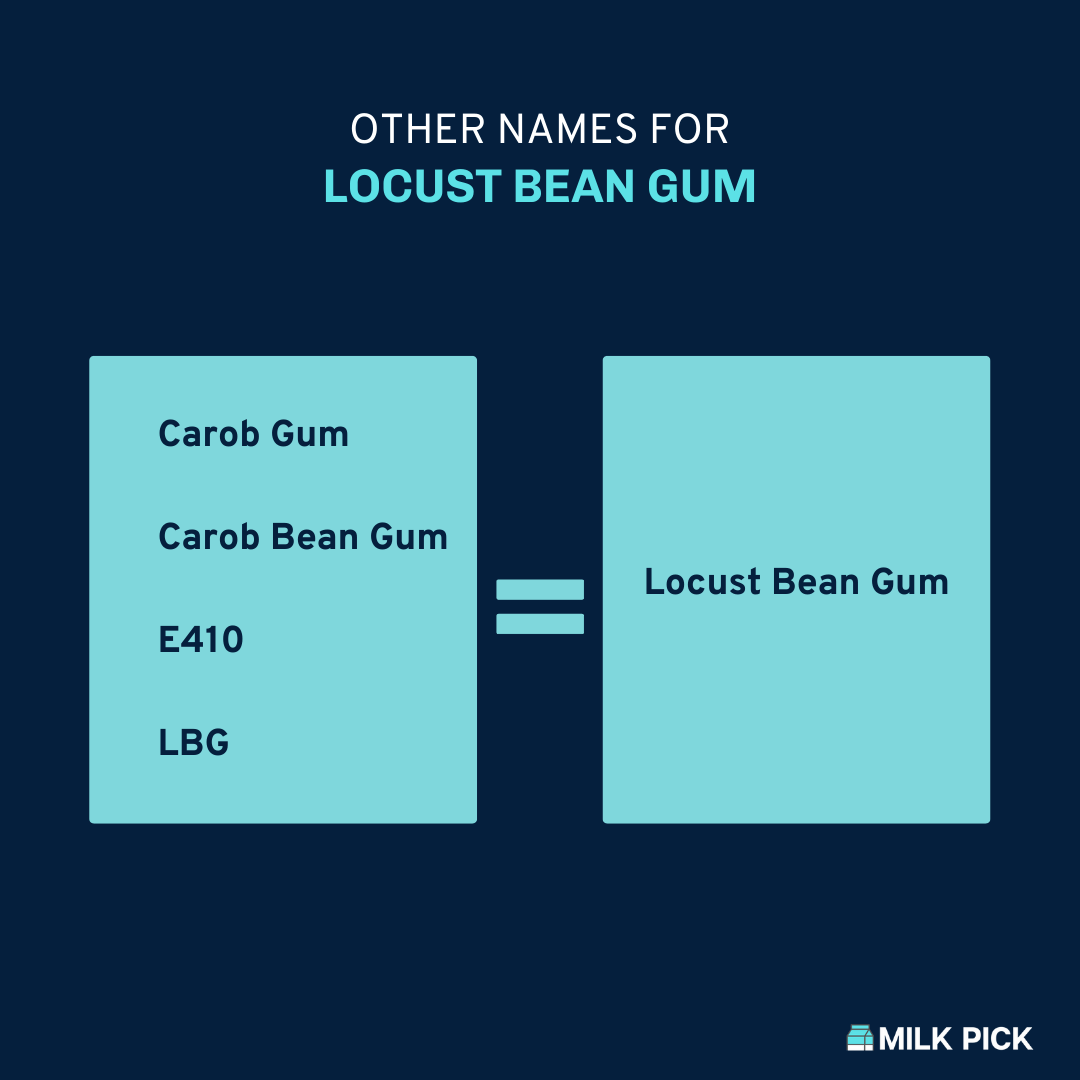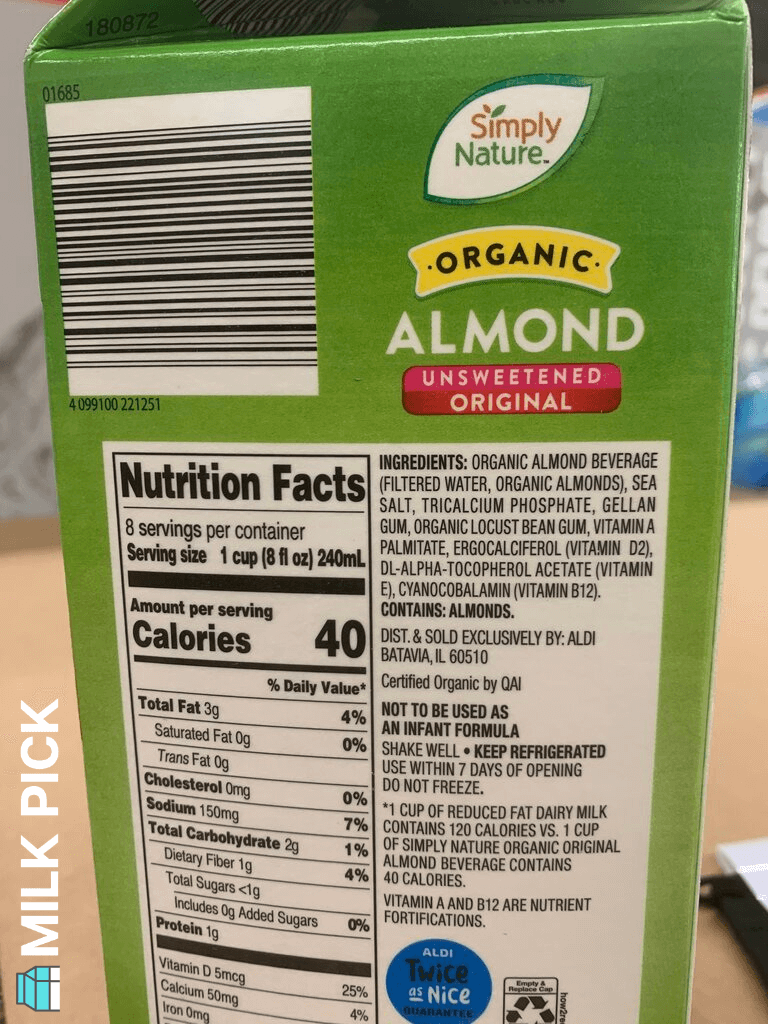If you see locust bean gum in your almond milk, you’re probably concerned grasshoppers were used to make it. While locust bean gum is, in fact, vegan and contains no grasshopper remnants, that doesn’t mean it’s good for you to consume.
Locust bean gum is an additive derived from carob tree seeds that is primarily used to enhance the thickness of a product. Locust bean gum may cause gastrointestinal irritation, block the absorption of important minerals, and could cause an allergic reaction.
This article will help you know exactly what locust bean gum is made of and understand its impact on your health so you can decide whether you’re comfortable with it being in your almond milk.
What is Locust Bean Gum?
Locust bean gum is an additive approved by the FDA to help thicken the texture of a product or stabilize the product to make it last longer.
Despite its deceiving name, locust bean gum is indeed vegan. It is formed using the seeds of a carob tree that is native to the Mediterranean.
Locust bean gum is primarily composed of indigestible fiber that can turn into a gel-like substance when mixed with liquid.
Locust bean gum goes by many names including its abbreviation LBG, carob gum, and carob bean gum. In the European Union, it is identified using its food additive number E410.

Why is Locust Bean Gum Used in Almond Milk?
Companies use locust bean gum in almond milk to enhance the overall texture of the milk.
In traditional cow milk, the naturally occurring fat provides a creamy texture.
Many plant-based milks lack that thickness that you may be accustomed to if you are used to drinking cow-based milk.
Manufacturers found that if they could use additives, they could thicken up their plant-based milk to make their product similar to what consumers were used to consuming.
In turn, this is thought to make the product more desirable to you, the consumer.
Locust bean gum is a particularly useful additive because, as we mentioned earlier, it turns into a gel-like substance when mixed with water.
This makes it an ideal substance to use to thicken and mimic the naturally occurring fat in cow-based milks.
What Does the FDA Say About Locust Bean Gum?
The FDA does officially recognize locust bean gum as a safe food additive. It has been approved to use as a food thickener and stabilizer.
The FDA does not differentiate which species of carob trees can and cannot be used to create the locust bean gum.
They also do not require that the exact amount of locust bean gum be listed on the product.
The FDA does, however, provide a list of the maximum percentage amount of locust bean gum allowed to be in the following products:
- Baked goods and baking mixes
- Cheeses
- Gelatins, fillings and puddings
- Jams and jellies
- Beverages and beverage bases
They also list a maximum amount for “all other food categories” for products that don’t fall under one of the mentioned categories.
Food | Percent of Locust Bean Gum Allowed |
|---|---|
Baked goods and baking mixes | 0.15 |
Beverages and beverage bases, nonalcoholic | 0.25 |
Cheese | 0.80 |
Gelatin, puddings, and fillings | 0.75 |
Commercial jams and jellies | 0.75 |
All other food categories | 0.50 |
Your Gastrointestinal Tract and Locust Bean Gum
Now that you know what locust bean gum is and that it is FDA approved, you might wonder if it impacts your health. Let’s dive into the research to answer that question.
Research has found that locust bean gum causes significant delays in gastric emptying. That’s a fancy way of saying that it causes severe indigestion and bloating.
If you suffer from irritable bowel syndrome, stomach ulcers, or any other gastrointestinal dysfunction, locust bean gum may increase your symptoms and cause notable discomfort.
The delayed gastric emptying caused by locust bean gum can also cause you to feel nauseous and even vomit, depending on how slowly your stomach empties out its contents.
I don’t know about you, but I’m not exactly interested in feeling sick to my stomach after consuming my almond milk.
Locust Bean Gum and Nutrient Absorption
Beyond causing gastrointestinal issues, locust bean gum may also block the absorption of important nutrients for your overall health.
Researchers found that consuming items with locust bean gum may temporarily block the absorption of key nutrients like zinc and iron.
The locust bean gum itself seems to bind to the nutrients, which does not allow them to get digested in your small intestine because locust bean gum is an indigestible fiber.
This means that if you add almond milk with locust bean gum to a smoothie containing leafy greens or other nutritious whole foods, your body may not be able to absorb the micronutrients in that smoothie.
Consequently, you’re missing out on the health benefits of the food by using a product with locust bean gum.
Locust Bean Gum and Children
You may also be somewhat concerned that research seems to be unclear on whether or not it is safe for children to consume locust bean gum.
Researchers reviewed all the available data regarding the impact of locust bean gum on the health of children and infants.
After looking at all the available data, they concluded that there isn’t enough information to determine if locust bean gum is safe for children and infants.
Studies have also determined that locust bean gum diminishes calcium absorption from infant formula, potentially impacting the development of the infant’s bones and teeth.
Needless to say, it may be best to opt for plant-based milk that doesn’t contain locust bean gum to keep your children safe from experiencing unwanted side effects on their health.
Locust Bean Gum and Allergies
There are some individuals who may be allergic to locust bean gum. As is the case with most food allergies, this could result in potentially serious side effects after consuming products with locust bean gum.
There have been noted cases of people experiencing severe respiratory side effects after being exposed to locust bean gum.
It’s important to note that allergy to locust bean gum was found in both adult and infant populations.
If you tend to be someone who suffers from food allergies, you may want to make sure locust bean gum isn’t found in your plant-based milk.
How Do You Know If Your Almond Milk has Locust Bean Gum?
Now that you’re equipped with all this knowledge about locust bean gum, you might be wondering how to figure out if it’s in your almond milk.
In products in America, you will find locust bean gum listed by its full name or carob bean gum on the ingredients list.

In Europe or on European products, it may be listed as E410.
Remember that the ingredient list is ordered from most to least used ingredients. Looking at where it is on the ingredient list gives you a relative idea of how much is used in that product.
If you want to control what goes in your almond milk and make sure it’s full of healthy ingredients, you can easily make your own almond milk at home without any unnecessary additives.
Should Locust Bean Gum Be in Your Almond Milk?
Locust bean gum is a food additive created from a carob tree's seeds that thickens the texture of commercial almond milk.
The FDA has approved the use of locust bean gum as an additive in a variety of food products, but the research remains unclear on whether it is safe for children and infants to consume locust bean gum.
Research has linked locust bean gum to delayed gastric emptying, which can increase symptoms related to IBS, ulcers, and other gastrointestinal health problems.
It’s also been linked to reduced absorption of key nutrients like zinc and iron.
There are noted cases of allergic reactions to locust bean gum that tend to result in respiratory issues. People with food allergies may want to be cautious when consuming products with locust bean gum.
You can make sure you and your loved ones are consuming almond milk that’s good for you by either making it at home or checking the ingredient list on the package to avoid locust bean gum.
